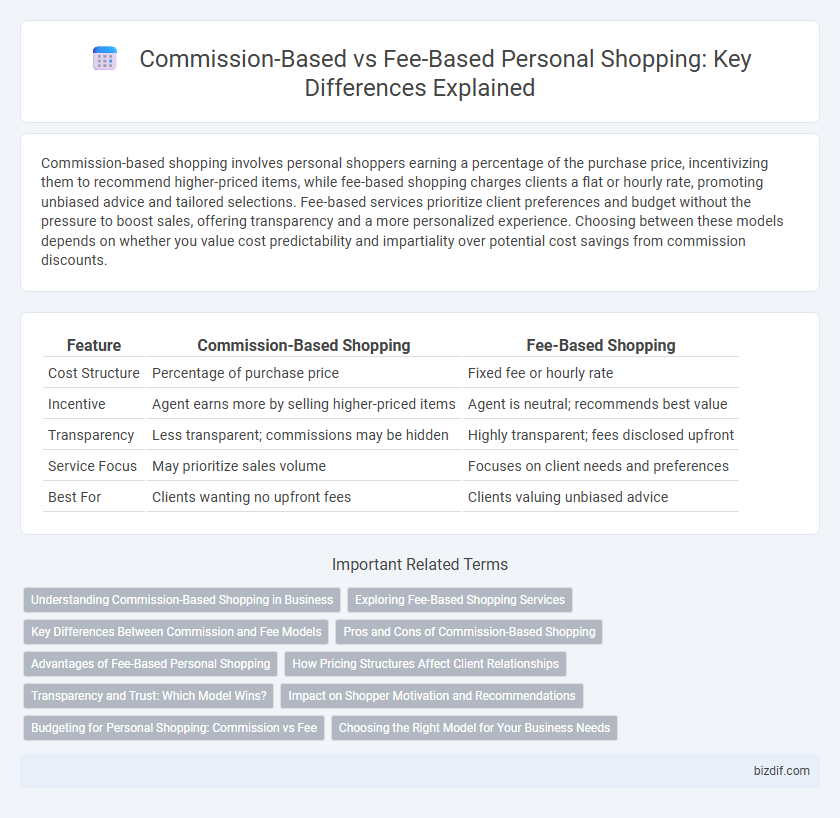Commission-based shopping involves personal shoppers earning a percentage of the purchase price, incentivizing them to recommend higher-priced items, while fee-based shopping charges clients a flat or hourly rate, promoting unbiased advice and tailored selections. Fee-based services prioritize client preferences and budget without the pressure to boost sales, offering transparency and a more personalized experience. Choosing between these models depends on whether you value cost predictability and impartiality over potential cost savings from commission discounts.
Table of Comparison
| Feature | Commission-Based Shopping | Fee-Based Shopping |
|---|---|---|
| Cost Structure | Percentage of purchase price | Fixed fee or hourly rate |
| Incentive | Agent earns more by selling higher-priced items | Agent is neutral; recommends best value |
| Transparency | Less transparent; commissions may be hidden | Highly transparent; fees disclosed upfront |
| Service Focus | May prioritize sales volume | Focuses on client needs and preferences |
| Best For | Clients wanting no upfront fees | Clients valuing unbiased advice |
Understanding Commission-Based Shopping in Business
Commission-based shopping in business involves personal shoppers earning a percentage of the total purchase price, incentivizing them to maximize sales volume. This model aligns the shopper's goals with client spending but may lead to biased product recommendations favoring higher commissions. Understanding these dynamics helps consumers make informed decisions when selecting personal shopping services.
Exploring Fee-Based Shopping Services
Fee-based shopping services charge a fixed or hourly fee for personalized shopping assistance, offering transparent costs and tailored recommendations without commission conflicts. Clients benefit from unbiased advice as fee-based shoppers are not incentivized by vendor commissions, enhancing trust and customization. This model suits shoppers seeking objective guidance and specialized expertise in purchasing decisions.
Key Differences Between Commission and Fee Models
Commission-based shopping involves personal shoppers earning a percentage of the purchase price, which can influence their recommendations towards higher-priced items or brands offering larger commissions. Fee-based shopping charges clients a fixed rate or hourly fee regardless of purchase amount, promoting unbiased advice tailored to the shopper's preferences and budget. The key differences lie in potential conflicts of interest and the transparency of costs, affecting trust and satisfaction in the personal shopping experience.
Pros and Cons of Commission-Based Shopping
Commission-based shopping incentivizes personal shoppers to find products that maximize their earnings, potentially leading to biased recommendations favoring higher-commission items. This model often requires no upfront fees, making it accessible for clients hesitant to invest before results but may increase overall costs with built-in commissions in product prices. However, the alignment of shopper incentives with sales can compromise objectivity, affecting customer trust and satisfaction over time.
Advantages of Fee-Based Personal Shopping
Fee-based personal shopping offers transparent pricing, eliminating conflicts of interest commonly associated with commission-based models where shoppers may prioritize higher-commission products. Clients benefit from unbiased recommendations tailored specifically to their preferences and needs, enhancing satisfaction and trust. This approach encourages personalized service and long-term relationships, as advisors focus solely on delivering value rather than sales volume.
How Pricing Structures Affect Client Relationships
Commission-based shopping incentivizes personal shoppers to recommend higher-priced products, which can sometimes lead to perceived bias in client relationships. Fee-based shopping fosters transparency by charging clients a flat or hourly rate, enhancing trust and long-term loyalty. Understanding these pricing structures helps clients choose services that align with their expectations for impartiality and value.
Transparency and Trust: Which Model Wins?
Commission-based shopping often raises concerns about transparency, as personal shoppers may prioritize retailers offering higher commissions, potentially compromising trust. Fee-based shopping provides clearer transparency, with clients paying a fixed amount regardless of purchase, fostering greater trust through unbiased recommendations. Consumers seeking honest guidance typically prefer fee-based models for their straightforward, conflict-free approach.
Impact on Shopper Motivation and Recommendations
Commission-based shopping often drives personal shoppers to prioritize high-commission products, potentially biasing recommendations toward higher-priced or promoted items. Fee-based shopping aligns incentives with client satisfaction, encouraging unbiased, tailored advice that focuses solely on meeting the shopper's preferences and needs. This alignment enhances shopper motivation to provide personalized guidance, boosting trust and long-term client relationships.
Budgeting for Personal Shopping: Commission vs Fee
Budgeting for personal shopping requires understanding the difference between commission-based and fee-based models, as commission shopping typically includes a percentage of the purchase price, often ranging from 10% to 20%, which can impact the overall budget unpredictably. Fee-based personal shopping involves a fixed rate or hourly fee, providing clearer cost expectations and more control over expenses. Choosing between these models depends on whether cost certainty or a performance-based incentive aligns better with your shopping priorities.
Choosing the Right Model for Your Business Needs
Commission-based shopping offers incentive-driven earnings tied directly to sales performance, ideal for businesses seeking motivated personal shoppers who align with revenue goals. Fee-based shopping ensures predictable costs through fixed charges, benefiting clients who prioritize transparent budgeting and personalized service without sales pressure. Selecting the right model depends on business objectives, client preferences, and the desired balance between cost structure and performance motivation.
Commission-based shopping vs Fee-based shopping Infographic

 bizdif.com
bizdif.com